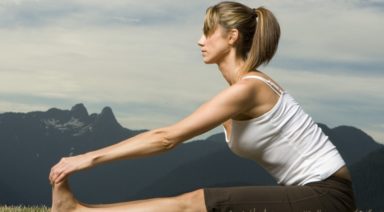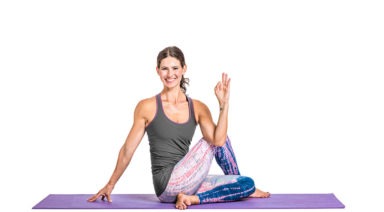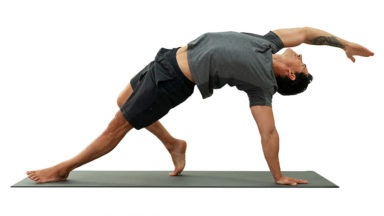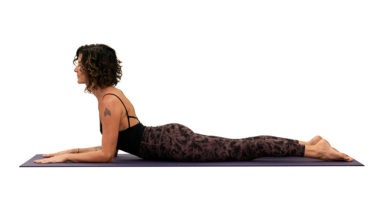Passive Stretch to Open the Hips

Open hips are a kind of holy grail in the world of yoga. If your hips are tight some of the most basic movement in yoga will be an eternal challenge. Lotus and half lotus posture is almost taken for granted in traditional yoga practices. Not every student of yoga has naturally open hips.
Those that are born tight suffer and strive to open their hips. If you rush the process of opening the hips the weaker joints nearby, most often the knees, take the brunt of the pressure and can often end of up injured.
While it’s easy to push hard and over-exert yourself in any activity it’s harder to find the perfect balance between activation and release that will create health and healing in the body. If you have tight hips and you want them to open your mission is not to open your hips but to find that healing balance.
If you practice a traditionally active style of yoga like Ashtanga Yoga and your hips are tight then it can be very useful to supplement your daily practice with some additional passive stretching. There are many stretches that can help target your hips, but this one will prepare your body especially well for lotus and half lotus position.
Called double pigeon, you want to go into this movement with a relaxed, almost meditative mind. Do not seek to strive or force anything. Bend both knees about half way and stack the right leg on top of the left so that the right foot is on top of the left knee and the left foot is underneath the right knee. If it’s uncomfortable to sit here then just stay in position.
If you are comfortable fold forward and relax all unnecessary effort. Breath freely and effortlessly. Surrender your body into the floor and place your mind on the inner body. See if you can feel the external rotation of your hip joints. Place your mind deep within the pelvis and be sure not to fight or struggle with yourself. Just be exactly where you are. Hold the first side for between one and give minutes. Then switch sides.
Adding a passive stretch like this to your daily yoga practice can help relax the mind and body and balance what may be a sometimes overly aggressive attempt to force the body to open. If you do try this posture the calm, meditative mind is perhaps the most beneficial aspect of the movement.
3 Exercises to Strengthen Your Hips and Balance Your Body

In yoga we often speak of tight hips, needing to open the hips, balancing the opening of our hips from side to side (etc), but there is more to a balanced body than open hips. We also need stability and support from our hips. This is important not only in yoga but also in day-to-day activities like simply walking. It is especially important if you are an athlete and need to perform on one leg.
A Look Inside the Hip Our hip musculature is made up of many muscles, large and small. For stability, we need the muscles of the side of the hip to be active and engaged. If you place your hands on the sides of your bony pelvis below your waist, you can imagine a tear-drop-shaped area below the ridge of your pelvis. The front part of the tear is the Tensor Fasciae Latae or TFL which connects with your IT band to join at the knee. At the back part of the teardrop are the Gluteus Medius and Minimus, which lie underneath your big Gluteus Maximus.
These muscles are what support and keep you steady in balance poses or when you transfer weight from one leg to the next as you walk or run. For many of us, these muscles are fast asleep, so we recruit our hip flexors at the front or our glutes and our hamstrings at the back to do a job they were not designed to do. Over time this can lead to low back pain and sacroiliac joint pain. Forcing our body to compensate will lead to problems over time. A look outside the hip Tree pose can be a simple test to see if we are accessing our side/lateral hip stabilizers.
Stand in front of the mirror and take a medium-size tree pose with your foot resting on the shin (even if you can go higher). Place your hands on your bony pelvis again and see if they are level from side to side. If not, press the shin into the foot and the foot back into the leg so that the standing hip drops to make the hips level. If this is too difficult to achieve, keep your foot off the ground but come out of tree pose so that your knee is facing forward, raised to hip level with the knee bent.
Try to level the hips again here by firmly rooting into the ground with the standing leg. My Three Favorite Lateral Hip Exercises Most of us can benefit from a little extra love and attention to the side of our hips. Try these exercises to wake up your hips and begin to stand taller on one leg
1. Kick the Ball Standing: Lift one foot off the ground. Keep your leg straight and send your heel forward, toes pointing out as if you were passing a soccer ball in slow motion. Reverse this motion by turning your toes in and sending your leg behind you. Flow forward and back, heel in and out, in a short arc. Don’t forget about your standing leg: root into the earth and don’t let the hip hitch out to the side. Repeat this motion ten times and then switch sides.
2. Clam Shell: Lie on your side with either your arm or a foam block supporting your head. Bend both hips to 90 degrees with knees bent, feet touching, stacked on top of each other. Slowly lift your top knee up towards the sky while keeping your feet together (as if you were a clamshell opening). Keep your hips stacked and avoid rotating with the pelvis. Lower, repeat times, and switch sides.
3. Bicycle: Lie on your side with both legs straight. Flex your feet, as if standing, and stack them on top of each other. Lift your top leg so that feet are hip-width apart. Keep this distance as you flow through this sequence: a) knee bent move forward to the hip at 90 degrees, b) straighten at the knee, c) float straight leg back to start. This should look like you are slowly pedaling a bike. Keep the hips stacked and stable. Strengthening our lateral hips will not only improve our yoga practice, but will also balance our body and prevent injury so that we continue to walk, vinyasa, and run for years to come.





































